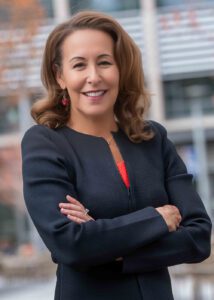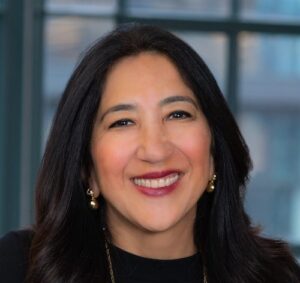Topic: Management
This VC believes in unions. Can he convince the rest of corporate America to join him?
New research finds that despite the stereotypes, women actually negotiate their salaries more than men
At Taser maker Axon, ex-staffers say loyalty meant being tased or tattooed
The Supreme Court is infected with the ‘most damaging’ human bias
Amid uncertainty about Francesca Gino’s research, the Many Co-Authors project could provide clarity
Smoking can help your career—but not always
Generational Divides: The Do’s and Don’ts of Generational Labels
‘Women do ask’: Haas professor dispels gender wage gap myths
New research shatters outdated pay-gap myth that women don’t negotiate

For decades, a cottage industry of books and workshops has promised to make women better negotiators and help close the gender pay gap. Yet not only does the pay gap persist, but it tends to be larger for women who gain advanced business skills.
New research by Berkeley Haas Professor Laura Kray shows the belief that women don’t ask for higher pay is not only outdated, but it may be hurting pay equity efforts. Contrary to popular belief, professional women now report negotiating their salaries more often than men, but they get turned down more often, Kray found.
“While men in the past may have been more likely than women to negotiate, the gender difference has since reversed,” says Kray, the Ned and Carol Spieker Chair in Leadership. “Continuing to put the blame on women for not negotiating away the gender pay gap does double damage, perpetuating gender stereotypes and weakening efforts to fight them.”
The new paper, co-authored by Vanderbilt University Associate Professor Jessica Kennedy, PhD 12, and Haas post-doctoral scholar Margaret Lee, is in press in the journal Academy of Management Discoveries.
Wage gap increases with higher pay
Overall, the gender wage gap in the United States has barely budged over the past 20 years. Last year, women earned about 22% less than men, on average. But broken down by income level, the situation is more nuanced: The gap for middle- and lower-wage women has actually decreased while the gap for those with higher salaries—where there is often more room for negotiations—has increased.
Statistics for the elite group of women who invest in earning MBA degrees are sobering. Women earn 88% of what men make after finishing their MBA, but only 63% of what men make 10 years later, past research by Kray and others has found. This pay gap among MBA graduates “is especially notable considering the nearly identical skills and qualifications held by men and women at the time the degree is conferred,” Kray and her co-authors write.
Women do ask
The researchers surveyed a nationally representative sample and confirmed the popular perception that women negotiate less than men and are less successful when they do; and that men are more likely to receive better pay without asking for it.
Yet when Kray and her co-authors analyzed a survey of students graduating from a top MBA program between 2015 to 2019, they found that significantly more women than men reported negotiating their job offers—54% versus 44%.
The researchers then delved into a 2019 alumni survey of 1,900 MBA graduates. The survey asked the MBAs for their salaries, and included a multipronged question about whether they had ever asked for raises or promotions; whether those negotiations had been successful; and whether they had received a raise or promotion without asking.
The analysis confirmed that people who ask for higher pay are indeed more likely to get higher pay than those who don’t ask. “People should be encouraged to ask,” they wrote.
But overall, they found that the women earned 22% less than the men. And other than women’s lower pay, the only differences that emerged along gender lines were that more women than men said they had attempted to negotiate, and more women reported that they had been turned down.
“Given women’s greater, not lesser, tendency to ask, a gender difference in negotiation propensity cannot account for the gender pay gap found in these alumni data,” the researchers wrote.
Revisiting past conclusions
Kray and her co-authors also used an updated statistical approach to revisit a 2018 meta-analysis that concluded that women were less likely to initiate negotiations—focusing on the nine prior studies published from 1982 to 2015 that measured gender differences in initiation of salary negotiations.
In their new analysis that parsed out changes in negotiation propensity over time, the researchers concluded that men did report higher rates of negotiating versus women early in the era. However, the gender difference appeared to disappear around 1994 and reversed beginning around 2007.
The trend has continued to grow since then, Kray says.
“There’s a good-news story here. Both men and women are negotiating more, and the increase is much greater for women than men,” Kray says. She noted that many factors may have contributed to women’s greater assertiveness over the past two decades, including the emphasis on negotiating and the “lean-in” movement sparked by Sheryl Sandberg’s book.
Blaming the victim
Still, the downside of messages such as lean-in has been to “blame the victim,” Kray says—putting the onus on women to fix the pay gap by working more and trying harder.
“If people believe men have better outcomes simply because they negotiate and women don’t, then they think we just need to train women to negotiate better rather than fixing a discriminatory system,” Kray says. “We call this a ‘legitimizing myth.’”
To explore attitudes about the causes of the pay gap and support for possible solutions, the researchers next conducted a series of experiments. In one, they asked 500 college-educated people with managerial experience to read a paragraph on the post-MBA pay-gap increase, and asked questions about what they think drives it.
About 15% mentioned differences in negotiation rates, and almost half mentioned women’s choices—including beliefs that women may be less ambitious, work fewer hours, or have less experience. About 64% mentioned lack of fairness, discrimination, and structural issues, such as the “old boys’ network,” or a glass ceiling preventing women from rising to the top.
Men were more likely to blame women’s choices for their lower pay, while women were more likely to mention discrimination. But over and above those explanations, men and women thought negotiation rates were a significant contributor to pay disparities. Those who believed more strongly that women’s lower negotiation rates contributed to the pay gap for MBA graduates were less likely to support legislation that prohibits employers from asking prospective employees about their current or past salaries—aimed at correcting past inequities—and more likely to justify the current system.
How gender-based messages can backfire
In one final experiment, Kray and her colleagues showed that messages intended to promote equality in negotiations can contribute to sexist stereotypes. After reading a passage from a book aimed at getting women to negotiate, people were more likely to endorse gender stereotypes than those who read from a gender-neutral negotiations book.
“Negotiating for pay or promotions is clearly beneficial, and given that negotiation rates are pretty low, there is a lot of room for everyone to do more negotiating,” Kray says. “But it’s time to end the notion that the pay gap occurs because women don’t ask.”
Kray is continuing to investigate the relationship between negotiations and outcomes, including whether the higher rates of women asking but being turned down leads to higher turnover, and whether this reflects negatively on employers. She is collaborating with Haas Dean Ann Harrison, who is focusing her sabbatical this fall on researching the causes of the gender wage gap.
Read the paper:
Now, Women Do Ask: A Call to Update Beliefs about the Gender Pay Gap
By Laura Kray, Jessica Kennedy, and Margaret Lee
Academy of Management Discoveries
Published online: August 15, 2023
Now, women do ask: A call to update beliefs about the gender pay gap
Juliana Schroeder: Mistakenly seeking solitude
How an MBA helps you get the position and salary you deserve
Prof. Jennifer Chatman wins lifetime achievement award for culture research that ‘changed the field’
Professor Jennifer Chatman has won a lifetime achievement award for “research on culture that has changed the field of organizational behavior,” according to an announcement from the Academy of Management’s Organizational Behavior Division.

Chatman, the Paul J. Cortese Distinguished Professor of Management and Associate Dean for Academic Affairs at Berkeley Haas, will receive the award at the OB@AOM conference in Boston next month.
Chatman has “pioneered new theoretical and conceptual approaches to the topic and continues to do so. She also has been a strong mentor to many doctoral students over the years. Finally, beyond her own work and the work of her students, she has contributed to the field as an editor…and editorial board member at almost all of our top journals,” according to the announcement.
In the early 1990s, Chatman co-created the field’s leading quantitative research tool, the Organizational Culture Profile, with Charles O’Reilly, MBA 71, PhD 75, and Dave Caldwell. It illustrated how organizational culture can be quantified, has defined the agenda for the scientific study of culture for decades, and remains the most robust and reliable measure of organizational culture to date.
In nominating Chatman, colleagues noted that she “owns the topic” of culture research and is a “household name” in the field. They also noted that her achievements span beyond being purely scholarly: “For more than 30 years, Jenny has been one of those rare scholars who are triple threats. They are able to be world class scholars over time even as they are leaders in our profession and their host institution,” describing her as “an icon in the field of organizational behavior, as a scholar, as an instructor, and as a mentor. Her career stretches long, well over 30 years, and during that time her work has been nothing short of pathbreaking” and the “ultimate exemplar of a completely involved modern OB researcher, educator, and contributor to the larger world of work and working.”
Chatman will continue to expand her leadership when she steps into the role of interim dean this fall, filling from October-December while Dean Ann Harrison is on sabbatical.
If you’ve felt like people are getting crueler, you may be right
Looking for the next big thing? Look to the fringes, deep-learning model shows

Subtle shifts in how people use language can foretell big changes in how we think about the world. For example, when followers of astronomer Copernicus stopped calling the sun a planet, it signaled the beginning of the end of the belief that the earth was the center of the universe.
Getting out ahead on far-sighted ideas can yield big financial or reputational rewards, but these can be difficult to spot, even though signals about the next big idea may be lurking in everyday language. Advances in natural language processing are now making it possible.
Berkeley Haas Professor Sameer Srivastava and co-authors have developed a deep learning model that can identify where and when prescient ideas—those that go against convention but later become widely adopted—first emerge.
By parsing millions of public utterances by senators, judges, and executives, they found that far-sighted ideas tend to emerge not from established leaders but rather in the language first used by those on the fringes.
“This is a way to go back and actually find when somebody first used an idea in a way that became prescient,” says Srivastava, whose research with Stanford’s Paul Vicinanza and Amir Goldberg was published in PNAS Nexus. “Our results suggest that those people were more likely to be on the periphery, rather than center, of their field.”
Upstarts or Apple?
Social scientists have long grappled with the question of where paradigm shifts originate, but evidence about where such world-changing ideas originate has often been anecdotal and contradictory. The theory of disruptive innovation, for example, assumes that the ideas behind revolutionary products or business models come from industry upstarts. Yet Apple released its groundbreaking iPhone when it was already a dominant company. And in the law, it’s the Supreme Court—the pinnacle of the establishment—that is generally seen as issuing landmark rulings.
Srivastava and his co-authors used a deep neural network known as Bidirectional Encoder Representations from Transformers (BERT) to unearth the linguistic markers of prescient ideas and trace how they became mainstream. They first defined “contextually novel ideas” as words or phrases that are used for the first time in a new context, and that also reframe the dominant assumptions in a particular field. Those that prove to be prescient ideas are “contextually novel” at the time they are uttered but later become commonplace. In other words, they foreshadow big changes.
Political outsiders
Among nearly five million floor speeches delivered by members of the U.S. Congress from 1961–2017, the model flagged Mississippi Senators John Stennis as the most prescient and James Eastland as the least prescient. Both fiercely opposed civil rights legislation in the 1960s, but the well-connected and powerful Eastland made his case with overtly racist rhetoric. Stennis, meanwhile, was “among the first to base his objections on the principles of ‘color blindness,’ limited government, and individual freedom,” the researchers wrote. This indirect set of arguments proved highly prescient, “laying the groundwork for contemporary conservative talking points on race relations in the U.S.”
Landmark lower courts
The same idea held true for the law.
In examining 4.2 million digitized federal and state legal rulings, the researchers found that landmark U.S. Supreme Court decisions, such as legalizing gay marriage or affirming the Affordable Care Act, tend to originate in lower courts. In fact, the most prescient decisions—those with the highest number of citations—were 22 times more likely to come from state appellate courts than the U.S. Supreme Court.
They also found that the likelihood of authoring a highly prescient decision declines as a judge is promoted from district court to appeals court. This lends further credence to the idea that novel ideas tend to come from those outside the center of a field, Srivastava said. “It’s hard to imagine that a judge would get promoted on the basis of becoming less prescient over time.”
Prescient businesses
In the business world, the researchers had a smaller dataset to work with, analyzing transcripts of the Q&A portion of public quarterly earnings conference calls. In these calls, managers often reveal strategy not found in press releases or official filings. The model flagged smaller firms as more prescient than larger, more established players. Highly prescient firms, according to the model, had above-average stock returns. (The authors are doing more work on business figures to expand the data pool.)
Implications
The findings have implications across many disciplines, says Srivastava, the Ewald T. Grether Professor of Business Administration and Public Policy. Rather than, for example, just examining article or patent citations, which may accrue disproportionately to those who have resources or social status, the language-based approach allows researchers to trace the context in which an idea is first born.
This may pave the way, he says, to more recognition for people who have been historically marginalized—such as women and minorities. “They may be the ones generating a lot of the ideas, even if they aren’t getting credit for all of them.”
Read the full paper:
A deep-learning model of prescient ideas demonstrates that they emerge from the periphery
By Paul Vicinanza, Amir Goldberg, and Sameer B. Srivastava
PNAS Nexus, 2023
More research by Sameer Srivastava:
Building an ‘irresistible’ employee-focused organization
How we compiled the 2023 edition of Best Workplaces for Innovators
The power of person-to-person contact
Finance exec Elena Gomez, BS 91, named new chair of Haas School Board
Elena Gomez, BS 91, a finance executive with more than 30 years of experience in leading global organizations, has been named the new chair of the Haas School Board. She is the first woman to serve in the role.

Gomez, chief financial officer at restaurant technology firm Toast, succeeds Jack Russi, BS 82, a national managing partner of corporate development at Deloitte. Russi, who recently retired after a 40-year career at Deloitte, served as Haas School Board chair for nine years.
“We are so thankful to Jack for his boundless wisdom and strategic guidance during his tenure,” said Dean Ann Harrison. “We know that Elena will continue Jack’s legacy of leadership excellence and we look forward to working with her to achieve so many of our future goals.”
The Haas School Board, which meets three times a year, advises the dean and supports the school’s strategic direction. Gomez began her three-year term July 1.
“I’m honored to have the opportunity to chair the board, and work alongside Ann and her amazing leadership team to continue to help Haas thrive,” Gomez said.
“I’m honored to have the opportunity to chair the board, and work alongside Ann and her amazing leadership team to continue to help Haas thrive.” – Elena Gomez
At Toast, Gomez directs finance and strategy, corporate development, accounting, treasury, and business operations. Prior to Toast, Gomez served as the chief financial officer at Zendesk, where she helped scale the company to over $1 billion in annual revenue. Gomez arrived at Zendesk after serving for six years as senior vice president of finance and strategy at Salesforce.
A strong advocate for more women and diverse leaders in business, Gomez served on the founding advisory council for the Center for Equity, Gender & Leadership at Haas. As a Haas Board member since 2019, Gomez, a first-generation college student, has worked with Harrison on strategies to promote inclusion and recruit and retain diverse students.
In a recent Haas podcast, Gomez, the daughter of El Salvadoran immigrants, discussed the importance of being a role model throughout her career. She said she wanted others to see that “not only am I Latina and female, but I want to excel in my role, to show the next generation what is possible.
Gomez is a member of the board of directors at Smartsheet and PagerDuty, and is on the board of The Boys and Girls Clubs of San Francisco. She was also named to the San Francisco Business Times’ 2017 list of “Most Influential Women in Business.”